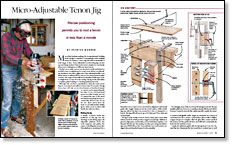Micro-Adjustable Tenon Jig
Precise positioning permits you to rout a tenon in less than a minute
Synopsis: Router expert Patrick Warner made a tenoning jig that will accommodate a wide range of sizes. He says it’s not sophisticated, but with a slight adjustment, he can dial in tenons to within 0.001 in. and cut 2-in.-long tenons in under a minute. His jig will only cut two-faced tenons or four-faced tenons on narrow stock, but he explains how to cut them on wider boards. A detailed drawing illustrates the parts of the jig, and Warner explains how to make one. Then he shows how to make tenons with it.
Most of the furniture making I do is experimental. Nothing in the design is standard. Consequently, when making tenons for joinery, I want a jig that will accommodate a wide range of sizes. Some adjustable woodworking jigs use the tap-and-clamp method. That works, but it’s simply not very handy when you’re making lots of different-sized tenons.
The jig I use to make tenons (see the photos at left and below) is nowhere near as sophisticated as some screw-driven woodworking machinery, but with a slight turn of the adjusting handle, I can dial in tenons to within 0.001 in. and cut 2-in.-long tenons in under a minute. The range of travel allows for shoulder widths up to 5⁄8 in. A straight bit in a router does the cutting. The jig works with either a template guide bushing or a bearing-guided pattern bit.
Although only one face is machined at a time, the work can be flipped, remounted and milled in fewer than 10 seconds. The jig shown here will only cut two-faced tenons or four-faced tenons on narrow stock (approximately less than 11⁄2 in.). For four-faced tenons on wider boards, you can (1) expand the size of the travel mechanism and clamp base to accommodate all four cuts; (2) cut the two short tenon faces by hand; or (3) build another similar jig for wider stock so that it will handle the other two faces.
Making the jig
A simple L-section forms the backbone of this jig. An adjustable platform above the work supports and guides the router, controlling the tenon size. This platform is positioned by a threaded rod (or lead screw) and held in alignment with metal guide rails. Toggle clamps secure the work in place, while a holding arm allows the jig to be secured in a vise or clamped to a bench. This jig will hold stock up to 8/4 thick and 10 in. wide and of any length.
The jig is made mostly of wood, but for many parts I used metal joinery methods, which produce rugged, accurate jigs. Rabbets or grooves align parts, and machine screws hold them together. I cut threads directly into the mating wooden part using machinist’s taps. You could also use wood screws, carriage bolts and threaded inserts for the assembly.
From Fine Woodworking #135
For the full article, download the PDF below:
Fine Woodworking Recommended Products

Starrett 4" Double Square

Hedgehog featherboards

Stanley Powerlock 16-ft. tape measure




















Log in or create an account to post a comment.
Sign up Log in